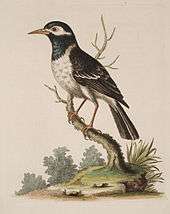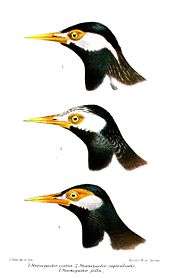Pied myna
The pied myna or Asian pied starling (Gracupica contra) is a species of starling found in the Indian subcontinent and Southeast Asia. They are usually found in small groups mainly on the plains and low foothills. They are often seen within cities and villages although they are not as bold as the common myna. They produce a range of calls made up of liquid notes. Several slight plumage variations exist in the populations and about five subspecies are named.
| Pied myna | |
|---|---|
.jpg) | |
| Uttar Pradesh, India
| |
| Scientific classification | |
| Kingdom: | Animalia |
| Phylum: | Chordata |
| Class: | Aves |
| Order: | Passeriformes |
| Family: | Sturnidae |
| Genus: | Gracupica |
| Species: | G. contra |
| Binomial name | |
| Gracupica contra | |
| Synonyms | |
|
Sturnus contra Linnaeus, 1758 | |
Taxonomy

The species has been included in the genus Sturnus and Sturnopastor in the past but recent studies do not support its inclusion within Sturnus leading to the reinstatement of an older genus name Gracupica.[2][3] It has been claimed that the species name "contra" is derived from an Indian name for it, although this has not been traced subsequently.[4]

The nominate subspecies (based on the species description given by Linnaeus in 1758) is found mainly along the Gangetic plains extending south into Andhra Pradesh and east to Bangladesh. The population in northeastern India (Sadiya to Tirap and the Naga Hills) was named as sordida (originally Sturnus contra sordidus) by Sidney Dillon Ripley in 1950. This form differs from the Indian form in having reduced streaking on the shoulders and nape. The populations in Manipur south to Myanmar and east to Yunnan have the white extending over the eye and are included in the subspecies superciliaris first described by Edward Blyth in 1863. The subspecies in Thailand, Laos and Cambodia is included in floweri ( Sharpe, 1897) while jalla described by Horsfield in 1821 is found on Sumatra, Java and Bali.[5][6]
Description
This myna is strikingly marked in black and white and has a yellowish bill with a reddish bill base. The bare skin around the eye is reddish. The upper body, throat and breast are black while the cheek, lores, wing coverts and rump are contrastingly white. The sexes are similar in plumage but young birds have dark brown in place of black.[5] The subspecies vary slightly in plumage, extent of streaking of the feathers and in measurements.
The flight is slow and butterfly-like on round wings.[7]
Leucistic individuals have been recorded.[8]
Distribution and habitat
The species is found mainly in the plains but in the foothills up to about 700m above sea level. They are found mainly in areas with access to open water. Their main distribution in India is from the Gangetic plains extending south to the Krishna River. Their range is increasing, with populations establishing more recently in Pakistan,[7][9] Rajkot,[10] and Bombay (since 1953),[11] possibly aided by trade in caged birds and accidental escape.[12] Their westerward spread in India particularly in parts of Rajasthan has been aided by changes in irrigation and farming patterns, and the spread into Sumatra has been aided by deforestation.[7][13] The species has also established itself in Dubai, UAE.[1]
The habitat is lowland open areas with scattered trees near water, often near human habitation. This species is often seen at sewage farms and refuse tips.[7]
Behaviour
_at_nest_on_Jarul_(Lagerstroemia_speciosa)_in_Kolkata_I_IMG_8745.jpg)
These starlings are usually found in small groups, foraging mainly on the ground but perching on trees and buildings. Birds in a group call frequently with a wide repertoire that includes whistles, trills, buzzes, clicks, and warbling calls. Young birds taken into captivity have been trained to imitate tunes of other birds.
Both sexes sing.[7] They forage in fields, lawns and on open ground feeding on grains, fruit, insects, earthworms and molluscs usually taken from the ground. Like many other starlings, they often use a prying or gaping action, piercing soil and then opening apart the bill to dislodge hidden food.[14] The strong protractor muscles allow them to part a mat of grass and their eyes are positioned to obtain a binocular view of the space between the parted beak.[15][16] They often feed in grazing land or among cattle.[7]
The breeding season in India is spread from March to September. With the onset of breeding, the sizes of flocks decline and birds pair up. Courtship involves calling, fluffing of the feathers and head bobbing. The nest is a loose mass of straw formed into a dome with an entrance on the side and placed in a large tree (often banyan, mango, jackfruit, rosewood[17]) or sometimes on man-made structures,[18] often close to human habitation. Several pairs will breed in the same vicinity. The usual clutch is made up of about four to six glossy blue eggs. Each egg is laid with a day in between and incubation begins only after the third or fourth egg is laid. The eggs hatch after 14 to 15 days. The young are brooded for two weeks, the female staying at the nest during the night. Both parents feed the chicks until they fledge and leave after three weeks. More than one brood may be raised in a season.[5][6][19]
An instance of interspecific feeding, where an adult of a common myna fed a young pied myna has been reported.[20]
These mynas form communal roosts at night and jointly defend nesting areas.[7]
In culture
The ability of these mynas to mimic human voices made them popular as cagebirds. The Sema Nagas will not eat this bird as they believe it is the reincarnation of a human.[21] They are considered to be generally beneficial because they eat many insects.[7]
References
- BirdLife International (2009). "Sturnus contra". IUCN Red List of Threatened Species. 2009. Retrieved 12 July 2011.CS1 maint: ref=harv (link)
- Zuccon, Dario; Cibois, Anne; Pasquet, Eric; Ericson, Per G. P. (2006). "Nuclear and mitochondrial sequence data reveal the major lineages of starlings, mynas and related taxa". Molecular Phylogenetics and Evolution. 41 (2): 333–344. doi:10.1016/j.ympev.2006.05.007. PMID 16806992.
- Lovette, I.; McCleery, B.; Talaba, A. & Rubenstein, D. (2008). "A complete species-level molecular phylogeny for the "Eurasian" starlings (Sturnidae: Sturnus, Acridotheres, and allies): Recent diversification in a highly social and dispersive avian group" (PDF). Molecular Phylogenetics & Evolution. 47 (1): 251–260. doi:10.1016/j.ympev.2008.01.020. PMID 18321732. Archived from the original (PDF) on 2009-02-05.
- Sundevall, CJ (1846). "The birds of Calcutta, collected and described by Carl J. Sundevall". Ann. Mag. Nat. Hist. 18: 303–309. doi:10.1080/037454809496589.
- Rasmussen, P.C.; Anderton, J.C. (2005). Birds of South Asia. The Ripley Guide. Volume 2. Washington DC and Barcelona: Smithsonian Institution and Lynx Edicions. p. 583.
- Ali, S & S D Ripley (1986). Handbook of the birds of India and Pakistan. Volume 5 (2nd ed.). New Delhi: Oxford University Press. pp. 172–175.
- Freare, Chris; Craig, Adrian (1998). Starlings and Mynas. London: Croom Helm. pp. 167–168. ISBN 071363961X.
- Inglis, CM (1904). "The birds of the Madhubani sub-division of the Darbhanga district, Tirhut, with notes on species noticed elsewhere in the district. Part VIII". J. Bombay Nat. Hist. Soc. 16 (1): 70–75.
- Murtaza, Syed Ali (1997). "Record of the sightings and breeding of Pied Mynah Sturnus contra at Lahore". J. Bombay Nat. Hist. Soc. 94 (3): 569–570.
- Raol, LM (1966). "Unexpected bird". Newsletter for Birdwatchers. 6 (7): 9–10.
- George, NJ (1971). "The Pied Myna, Sturnus contra (Linnaeus) in Bombay". J. Bombay Nat. Hist. Soc. 68 (1): 243–244.
- Naik, Vasant R (1987). "Nest of the Pied Myna Sturnus contra Linnaeus". J. Bombay Nat. Hist. Soc. 84 (1): 210.
- Sharma SK (2004). "Present distribution of Asian Pied Starling Sturnus contra in Rajasthan". Zoos' Print Journal. 19 (12): 1716–1718. doi:10.11609/jott.zpj.1222.1716-8.
- Zuccon, Dario; Pasquet, Eric; Ericson, Per G. P. (2008). "Phylogenetic relationships among Palearctic–Oriental starlings and mynas (genera Sturnus and Acridotheres: Sturnidae)" (PDF). Zoologica Scripta. 37 (5): 469–481. doi:10.1111/j.1463-6409.2008.00339.x.
- Beecher, William J. (1953). "A phylogeny of the Oscines" (PDF). Auk. 70 (3): 270–333. doi:10.2307/4081321. JSTOR 4081321.
- Mayr, Gerald (2005). "A new eocene Chascacocolius-like mousebird (Aves: Coliiformes) with a remarkable gaping adaptation" (PDF). Organisms, Diversity & Evolution. 5 (3): 167–171. doi:10.1016/j.ode.2004.10.013.
- Pandey, Deep Narayan (1991). "Nesting habitat selection by the Pied Myna Sturnus contra Linn". J. Bombay Nat. Hist. Soc. 88 (2): 285–286.
- Tiwari, JK (1992). "An unusual nesting site of Pied Myna". Newsletter for Birdwatchers. 32 (3–4): 12.
- Narang, ML; Tyagi, AK; Lamba, BS (1978). "A contribution to the ecology of Indian Pied Myna, Sturnus contra contra Linnaeus". J. Bombay Nat. Hist. Soc. 75: 1157–1177.
- Inglis, CM (1910). "Common Myna (A. tristis) feeding young of Pied Myna (S. contra) and nesting habits of the Common Pariah Kite (M. govinda) and Brahminy Kite (H. indus)". Journal of the Bombay Natural History Society. 19 (4): 985.
- Hutton JH (1921). The Sema Nagas. London: Macmillan and Co. p. 92.
Other sources
- Ray, D (1972) Pied Myna Sturnus contra in Delhi. Newsletter for Birdwatchers. 12(10):11.
- Narang, ML; Lamba, BS (1976) On the feeding-time and feeding-area preference of Indian Pied Myna, Sturnus contra Linn. Newsl. Zool. Surv. India 2(3), 83–86.
- Gupta, AP (1982) About the distribution of birds. Newsletter for Birdwatchers. 22(2):10
- Saini, Harjeet K; Chawla, Geeta; Dhindsa, Manjit S (1995): Food of Pied Myna Sturnus contra in the agroecosystem of Punjab. Pavo 33(1&2):47–62.
- Chawla, G (1993) Ecological studies on the Pied Myna (Sturnus contra) in an intensively cultivated area. M.Sc. Thesis, Punjab Agricultural University, Ludhiana.
- Gupta, SK & BR Maiti (1986). "Study of atresia in the ovary during the annual reproductive cycle and nesting cycle of the pied myna". Journal of Morphology. 190 (3): 285–296. doi:10.1002/jmor.1051900305.
- Gupta SK & B. R. Maiti (1987). "The male sex accessories in the annual reproductive cycle of the Pied Myna Sturnus contra contra". J. Yamashina Inst. Ornithol. 19: 45–55. doi:10.3312/jyio1952.19.45.
- Islam, M.S. (2001). "Southward Migration of Shorebirds in the Ganges Delta, Bangladesh" (PDF). The Stilt. 39 (31–36): 34.
- Tyagi, A.K.; Lamba, B.S. A contribution to the breeding biology of two Indian mynas. Miscellaneous publication. Occasional paper no. 5 (PDF). Calcutta: Zoological Survey of India.
